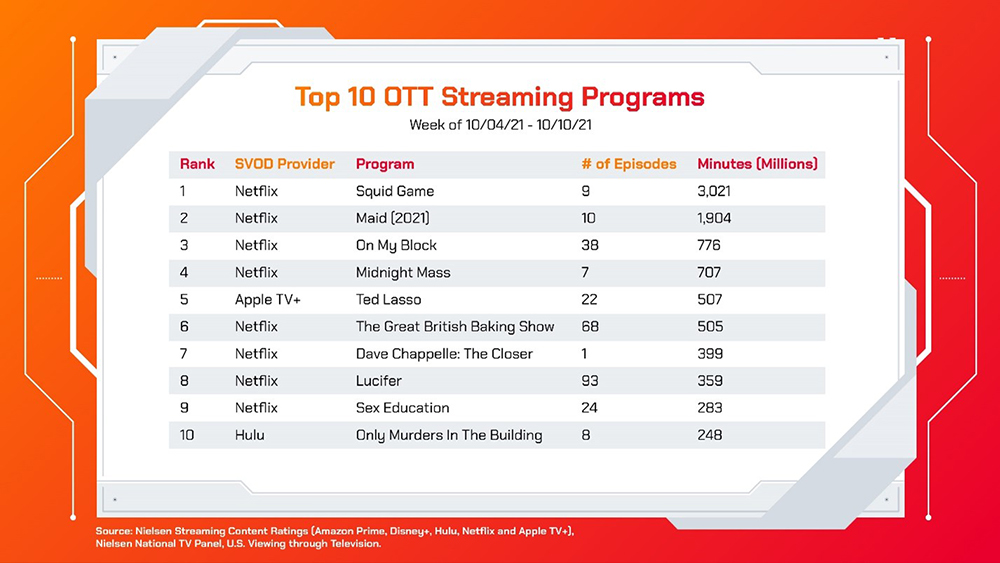It seems that everywhere you turn, people are talking about the Squid Game series on Netflix. It’s become a global phenomenon that has prompted millions of viewers to login into the platform and stream the show to their favorite devices.

Figure 1. Top 10 OTT Streaming Programs – Week of 10/04/21 – 10/10/21
It’s also a prime example of why the competitiveness of OTT (over-the-top) streaming services such as Netflix, Hulu, Disney+ and others has become so fierce. Sometimes, it only takes one overnight sensation show, something like Squid Game, to drive greater awareness and new subscriptions.
But unlike traditional television, which broadcasts shows at set times through an over-the-air transmissions, or even cable television programming, which also follows a structured scheduled and broadcasts through a set-top box, streaming services offer the flexibility for viewers to watch what they want to watch, when they want to watch and on the device of their choosing.

Figure 2. Netflix Paid Net Subscriber Additions – Q3 2021
Despite massive gains for Netflix in the early part of the pandemic in 2020, the company’s subscriber growth had largely curtailed – until the third quarter of 2021, the same time period for Squid Game’s debut. In that quarter, the company saw 4.4 million new subscribers – double what it reported for Q3 in 2020. In part, the credit goes to the show itself, which has been viewed by at least two-thirds of Netflix subscribers.
Streaming Popularity Creates Data Explosion, Expands Tech Innovation
And now that the expansions of broadband infrastructure, public wi-fi and unlimited wireless data plans are driving even more people online, the growth of the market has exploded. And that’s created opportunities for technology companies to innovate for the growing demand.
Consider that streaming programming, unlike traditional broadcasts, can be viewed with smartphones, tablets, PCs, smart TVs, and other connected devices. The greater availability means that the demand for OTT increases, as does the amount of data passing through a network. More data creates more demand on data center storage and that’s leading to greater innovation in semiconductor memory technologies and the evolution of the industry.

Figure 3. Worldwide Cloud Infrastructure Service Spend Q1 2018 – Q3 2021
The high quality video that audiences are demanding from streaming content providers creates greater amounts of data and requires technology that can deliver improved resolutions at a higher rate. In the end, it all comes to down to power and the performance of the semiconductors that are literally doing much of the technology heavy lifting behind-the-scenes.

Figure 4. SK hynix HBM3 DRAM Memory
In recent months, the innovation in semiconductor performance is adapting to new trends in video. In October, SK hynix announced that it has become the first in the industry to successfully develop the High Bandwidth Memory 3, the world’s best-performing DRAM. HBM3 is expected to be mainly adopted by high-performance data centers, and such a state-of-the-art memory solution will no doubt contribute to provide users with crystal clear video content with little latency.
Prior to that, SK hynix completed development of the industry’s most multilayered 176-layer 512 Gigabit (Gb) Triple-Level Cell (TLC) 4D NAND flash, a third-generation 4D product that secures the best number of chips per wafer. The result is an improvement in bit productivity, read speed and data transfer speed, and with such improvement the latest 176-layer 4D NAND Flash can be applied to both high performance enterprise SSDs for data centers and mobile storage solutions. Specifically, mobile solution products are expected to improve maximum read speed by 70 percent and maximum write speed by 35 percent.

Figure 5. SK hynix 18GB LPDDR5 Mobile DRAM
To stream such high-quality video with no latency on various mobile devices, it is also essential to support your devices with cutting edge mobile memory solutions. In March, SK hynix announced mass production of 18GB (gigabyte) LPDDR5 mobile DRAM, which offers the industry’s largest capacity, for premium smartphones, allowing support for high-quality video. That application will continue expanding to include the latest technologies, including ultra-high-performance camera applications and artificial intelligence (AI).
These are important developments because, increasingly, these powerful mobile devices with high-performance image and video capture capabilities are being marketed as commercial-like video equipment. Most recently, Apple’s iPhone 13 Pro is being advertised as “Hollywood in your Pocket” because of its ground-breaking video capabilities.

Figure 6. Mobile Phone Semiconductor Revenue – Q3 2021
Looking ahead, the demand for semiconductor innovation is ahead of the demand for devices where they’re found. Mobile phone shipments, for example, were down in 2020 but mobile phone semiconductor revenue grew nearly 10 percent due to a shift to higher-priced 5G devices which require high-end quality semiconductors. Demand remains strong as IDC forecasts 12.5 percent growth in 2021.
As we demonstrated, the chain of data for OTT streaming services travels from massive hyper-scale data centers all the way to your tiny mobile devices. The OTT streaming services might be among many other applications and services which drive growth momentum in such data ecosystem – but the demand that they’re creating with unique content such as the Squid Game is creating opportunities for companies like SK hynix, which will continue to innovate technologies that can offer greater performance, capabilities, and experiences across many different aspects of our daily lives.







